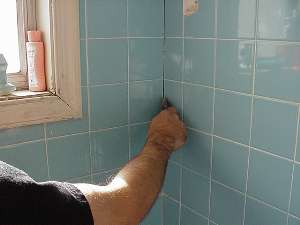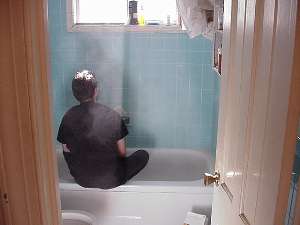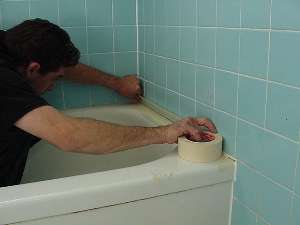|
Cutting the Pieces
The first thing to do is to
remove the old caulk, grout and grime that are in the corners, between the
tub and the wall and between the tub and the floor. These surfaces
must be free of old grout, caulk and grime for the caulk to form a good
seal. Remember that where two surfaces meet it is usually best to
use caulk.
The best method for removing the old grout is to start
with a utility (razor) knife. If there is crumbling grout, simply
run the knife down the joint several times until it comes loose. Use
a reasonable amount of pressure. The knife will rapidly become dull
but is not necessary to replace the blade until it becomes completely dull
or breaks. If the grout is very stubborn, you may have to use a
grout
saw.
The best way to get rid of the caulk is to use a
single-edge razor blade and cut/scrape it out. If you make a cut
against each wall and then scrape it out it will likely start to
"roll" out of the joint and is fairly easy to remove.
There is no magic way to get rid of grime (soap scum,
etc). Good, old-fashioned elbow grease is best but make sure that if
you use a cleaner that it does not leave a residue. Sometimes we
find that a normal scouring pad, used dry, will get rid of soap scum as
effectively as the best cleaners.
Examine the hardware (valves handles and spigot).
If there is buildup around the flanges then it is best to remove them and
cleanup the tiles and hardware. The handles are usually held in by a
screw. Sometimes there is a faceplate that must be removed.
The spigot can be the most challenging. Look on the underside of the
spigot. If there is a hole in the bottom towards the wall, a
hex-head screw will likely be holding the spigot on. Loosen the
screw to remove the spigot. If there is no screw, the spigot might
be screwed on. Turn the spigot with a pipe wrench. DO NOT get
to tough with it. If it does not come off easily, forget it and
clean it up the best you can.
After all of the old sealer is removed, clean up all of
the leftover debris. The area must me clean! After vacuuming
or wiping up the debris, we like to clean the area to be caulked with a
solvent. One that we find works well is mineral spirits. Just
a quick wipe down to get rid of any residue. Let the cleaner dry
completely before continuing. MAKE SURE
that if you use a solvent it will not harm your surround.
|

|


